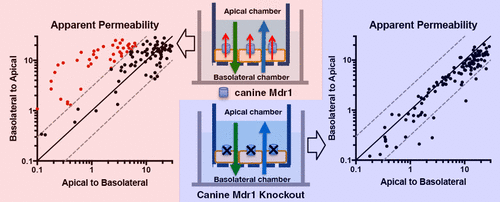当前位置:
X-MOL 学术
›
Mol. Pharmaceutics
›
论文详情
Our official English website, www.x-mol.net, welcomes your
feedback! (Note: you will need to create a separate account there.)
Evaluating the Utility of Canine Mdr1 Knockout Madin-Darby Canine Kidney I Cells in Permeability Screening and Efflux Substrate Determination
Molecular Pharmaceutics ( IF 4.5 ) Pub Date : 2018-09-17 00:00:00 , DOI: 10.1021/acs.molpharmaceut.8b00688 Eugene C. Chen 1 , Fabio Broccatelli 1 , Emile Plise 1 , Buyun Chen 1 , Liling Liu 1 , Jonathan Cheong 1 , Shu Zhang 1 , Jamie Jorski 1 , Katherine Gaffney 1 , Kayla K. Umemoto 1 , Laurent Salphati 1
Molecular Pharmaceutics ( IF 4.5 ) Pub Date : 2018-09-17 00:00:00 , DOI: 10.1021/acs.molpharmaceut.8b00688 Eugene C. Chen 1 , Fabio Broccatelli 1 , Emile Plise 1 , Buyun Chen 1 , Liling Liu 1 , Jonathan Cheong 1 , Shu Zhang 1 , Jamie Jorski 1 , Katherine Gaffney 1 , Kayla K. Umemoto 1 , Laurent Salphati 1
Affiliation

|
Permeability assays are commonly conducted with Madin-Darby canine kidney (MDCK) cells to predict the intestinal absorption of small-molecule drug candidates. In addition, MDCK cells transfected to overexpress efflux transporters are often used to identify substrates. However, MDCK cells exhibit endogenous efflux activity for a significant proportion of experimental compounds, potentially leading to the underestimation of permeability and confounded findings in transport studies. The goal of this study was to evaluate canine Mdr1 knockout MDCK (gMDCKI) cells in permeability screening and human MDR1 substrate determination in a drug discovery setting. The gMDCKI cells were established by CRISPR-Cas9-mediated knockout of the canine Mdr1 gene in MDCKI wildtype (wt) cells. A comparison of efflux ratios (ER) between MDCKI wt and gMDCKI showed that out of 135 compounds tested, 38% showed efflux activity in MDCKI wt, while no significant efflux was observed in gMDCKI cells. Apparent permeability (Papp) from apical-to-basolateral (A-to-B) and basolateral-to-apical were near unity in gMDCKI cells, which approximated passive permeability, and 17% of compounds demonstrated increases in their Papp A-to-B values. Overexpression of human MDR1 in gMDCKI (gMDCKI-MDR1) cells enabled substrate determination without the contribution of endogenous efflux, and the assay was able to deconvolute ambiguous results from MDCKI-MDR1 and identify species differences in substrate specificity. An analysis of 395 and 474 compounds in gMDCKI and gMDCKI-MDR1, respectively, suggested physicochemical properties that were associated with low permeability correlated with MDR1 recognition. Poorly permeable compounds and MDR1 substrates were more likely to be large, flexible, and more capable of forming external hydrogen bonds. On the basis of our evaluation, we concluded that gMDCKI is a better cell line for permeability screening and efflux substrate determination than the MDCK wt cell line.
中文翻译:

评价犬Mdr1基因敲除Madin-Darby犬肾I细胞在通透性筛选和外排底物测定中的效用
通透性测定通常使用Madin-Darby犬肾(MDCK)细胞进行,以预测小分子候选药物的肠道吸收。另外,转染过表达外排转运蛋白的MDCK细胞通常用于鉴定底物。然而,MDCK细胞对很大比例的实验化合物均表现出内源性外排活性,可能导致对通透性的低估和运输研究中的混淆结果。这项研究的目的是在药物发现环境中评估通透性筛选和人类MDR1底物测定中的犬Mdr1基因敲除MDCK(gMDCKI)细胞。gMDCKI细胞是通过CRISPR-Cas9介导的MDCKI野生型(wt)细胞中犬Mdr1基因的敲除而建立的。比较MDCKI wt和gMDCKI之间的流出比(ER),发现在测试的135种化合物中,有38%的化合物在MDCKI wt中显示出流出活性,而在gMDCKI细胞中未观察到明显的流出。在gMDCKI细胞中,从顶端到基底外侧(A到B)和从基底外侧到顶端的表观通透性(Papp)接近于1,这近似于被动渗透性,并且17%的化合物证明其Papp A到通透性增加B值。人类MDR1在gMDCKI(gMDCKI-MDR1)细胞中的过表达使得能够进行底物测定而没有内源性外流的作用,并且该测定方法能够使MDCKI-MDR1的模棱两可的结果反卷积并鉴定底物特异性的物种差异。分别分析了gMDCKI和gMDCKI-MDR1中的395和474种化合物,提示与低渗透性相关的理化性质与MDR1识别有关。渗透性差的化合物和MDR1底物更可能较大,柔韧性好,并且更有能力形成外部氢键。根据我们的评估,我们得出结论,与MDCK wt细胞系相比,gMDCKI是用于渗透性筛选和外排底物测定的更好的细胞系。
更新日期:2018-09-17
中文翻译:

评价犬Mdr1基因敲除Madin-Darby犬肾I细胞在通透性筛选和外排底物测定中的效用
通透性测定通常使用Madin-Darby犬肾(MDCK)细胞进行,以预测小分子候选药物的肠道吸收。另外,转染过表达外排转运蛋白的MDCK细胞通常用于鉴定底物。然而,MDCK细胞对很大比例的实验化合物均表现出内源性外排活性,可能导致对通透性的低估和运输研究中的混淆结果。这项研究的目的是在药物发现环境中评估通透性筛选和人类MDR1底物测定中的犬Mdr1基因敲除MDCK(gMDCKI)细胞。gMDCKI细胞是通过CRISPR-Cas9介导的MDCKI野生型(wt)细胞中犬Mdr1基因的敲除而建立的。比较MDCKI wt和gMDCKI之间的流出比(ER),发现在测试的135种化合物中,有38%的化合物在MDCKI wt中显示出流出活性,而在gMDCKI细胞中未观察到明显的流出。在gMDCKI细胞中,从顶端到基底外侧(A到B)和从基底外侧到顶端的表观通透性(Papp)接近于1,这近似于被动渗透性,并且17%的化合物证明其Papp A到通透性增加B值。人类MDR1在gMDCKI(gMDCKI-MDR1)细胞中的过表达使得能够进行底物测定而没有内源性外流的作用,并且该测定方法能够使MDCKI-MDR1的模棱两可的结果反卷积并鉴定底物特异性的物种差异。分别分析了gMDCKI和gMDCKI-MDR1中的395和474种化合物,提示与低渗透性相关的理化性质与MDR1识别有关。渗透性差的化合物和MDR1底物更可能较大,柔韧性好,并且更有能力形成外部氢键。根据我们的评估,我们得出结论,与MDCK wt细胞系相比,gMDCKI是用于渗透性筛选和外排底物测定的更好的细胞系。











































 京公网安备 11010802027423号
京公网安备 11010802027423号